| Ownership mark | Description | Notes |
|---|---|---|
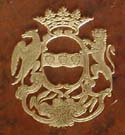 |
Coat of arms in gold with three linden leaves. Supported by an eagle and a lion. Placed on the front cover. |
Count J.H.E. Bernstorff (1712-1772), collector of books, diplomat, minister of foreign affairs. A considerable part of his library, but not all of it, was bought by the Royal Library in 1803. Monsieur de ***: Poësies heroïques, morales et satyriques (1696). |
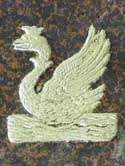 |
Super ex libris in gold: a crowned swan with a crown around its neck, too. Placed on the front cover. |
Count Christian Danneskiold-Samsøe (1702-1728), collector of books. Despite his early death he managed to collect a library comprising more than 7,500 printed books and c. 525 manuscripts. His collection was sold at auction after his death, and the Royal Library bought a great deal of books and manuscripts, but not all of them. This binding was probably made by Johann Boppenhausen. Jo. Alberti Fabricii Bibliothecæ Græcæ, vol. 11 (1722). |
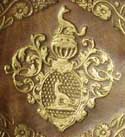 |
Coat of arms in gold with a sitting fox. The crest is also a sitting fox. Placed on the spine, in the top compartment. |
Niels Foss (1670-1751), collector of books, landowner, etatsråd (councillor of state). His library comprised c. 11,500 volumes which were sold at auction after his death. The Royal Library and the University Library (now part of the Royal Library) bought a large part of the collection, but not all of it. This binding was made by Johann Boppenhausen. Chronologia in Titi Livii Historiam (1568). |
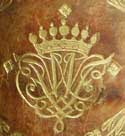 |
Crowned back-to-back monogram in gold. Placed on the spine, in the bottom compartment. |
Niels Foss (1670-1751), collector of books, landowner, etatsråd (councillor of state). His library comprised c. 11,500 volumes which were sold at auction after his death. The Royal Library and the University Library (now part of the Royal Library) bought a large part of the collection, but not all of it. This binding was made by Johann Boppenhausen. Chronologia in Titi Livii Historiam (1568). |
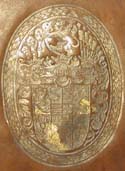 |
Coat of arms in gold with the lion of Norway, the two lions of Schleswig, the nettle leaf of Holstein, the swan of Stormarn, and the horseman of the Ditmarshes. On the inescutcheon the quartered arms of Delmenhorst-Oldenburg. The three crests are a plume, the lion of Norway, and seven lances. Placed on the front cover or the back cover. |
Duke Friedrich III of Schleswig-Holstein-Gottorp (1597-1659). The Duke’s father Johann Adolf (see his coat of arms here) founded a library at Gottorp Castle in 1606. It was captured by the Danish King in 1713 and transferred to the Royal Library between 1735 and 1749. However, the collection included a lot of duplicates which were given to other libraries. This is only one of a number of various Gottorp coats of arms. They all consist of the same components (also a pair of keys and a mitre, which are not seen here, can be found), but the order and the inescutcheon may vary from person to person. Borchardus: Descriptio Terræ Sanctae, et regionum finitimarum (1587). |
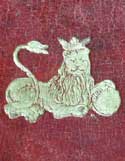 |
Super ex libris in gold: a crowned, lying lion with a ball under its left paw. Placed on the front cover. |
Gyldenløve, maybe Christian (1674-1703) or Ulrik Christian (1678-1719). The name Gyldenløve (which means golden lion) was given to the illegitimate children of the kings Christian IV ((b. 1577) 1588-1648), Frederik III ((b. 1609) 1648-1670), and Christian V ((b. 1646) 1670-1699). Mateo Aleman: Primera parte de Guzman de Alfarache (1599). |
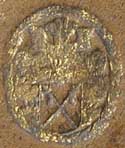 |
Coat of arms in gold with two crossed halberds. The crest is a plume between two wings. Placed on the front cover. |
Christian Herman Helwerskov (-1733), High Court judge, justitsråd (a minor Danish title), owner of the estates Irup and Øland in Thy, Northern Jutland. Willem Iansz Blaeuw: Zeespiegel, inhoudende en korte Onderwysinghe inde konst der Zeevaert (1631). |
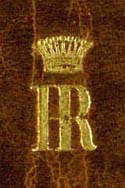 |
Crowned monogram in gold: HR Den Hielmstierne-Rosencroneske Samling (The Hielmstierne-Rosencrone Collection). Placed on the spine, in the top compartment. |
Henrik Hielmstierne (1715-1780), collector of books, civil servant. His library comprised c. 10,000 volumes which his daughter and her husband, Prime Minister Count M.G. Rosencrone, inherited. They donated the entire collection to the Royal Library in 1807, and it is still known as Den Hielmstierne-Rosencroneske Samling (The Hielmstierne-Rosencrone Collection). See Hielmstierne’s ex libris inside the book here. Olaus Magnus: Historia de gentibus septentrionalibus … (1555). |
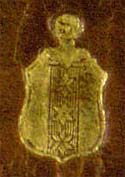 |
Coat of arms in gold with three vertically placed stars. Placed on the spine, in the bottom compartment. |
Henrik Hielmstierne (1715-1780), collector of books, civil servant. His library comprised c. 10,000 volumes which his daughter and her husband, Prime Minister Count M.G. Rosencrone, inherited. They donated the entire collection to the Royal Library in 1807, and it is still known as Den Hielmstierne-Rosencroneske Samling (The Hielmstierne-Rosencrone Collection). See Hielmstierne’s ex libris inside the book here. Olaus Magnus: Historia de gentibus septentrionalibus … (1555). |
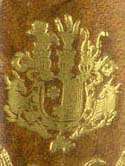 |
Coat of arms in gold with one and a half roses and a wing. The three crests are a horse, a bull’s head with a wing between its horns, and a bird between two bullhorns. Supported by two bulls with double tails. Hanging below, the Order of the Elephant. Placed on the spine, in the top compartment. |
Count Johan Ludvig Holstein (1694-1763), collector of books, politician. He collected a library of c. 30,000 volumes (of which 10,000 dissertations) in his castle Ledreborg near Roskilde. Among the many valuable books were almost 2,000 of Luther’s writings (bought at the auction of Bishop Peder Hersleb’s books in 1758) and 670 Bibles (bought at the auction of the theologian J.M. Kraft’s books in 1752), all of which purchased by the Royal Library in 1812. All but a very few of Holstein’s c. 1,000 manuscripts were donated to the Royal Library in 1925; this collection is called Den Ledreborgske Håndskriftsamling (The Ledreborg Manuscript Collection). See the common Holstein binding here. Erasmus Sarcerius: Ein warnung büchlein ... (1551). |
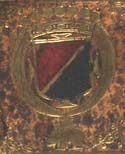 |
Coat of arms in gold divided diagonally into a red and a blue or black part. Hanging below, the Order of the Elephant. Placed on the spine, in the top compartment. |
Just Høg (1640-1694), diplomat, vice-governor of Norway. When his library was sold at auction in 1695, the King bought 300-400 books for his library. So, only part of Høg’s collection came into the possession of the Royal Library. See his signature inside the book here. Estienne Perard: Recueil de plusieurs pieces curieuses servant a l’histoire de Bourgogne (1664). |
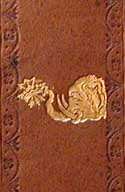 |
Super ex libris in gold, black, or blind tooled: an elephant’s head holding in its trunk a crown pierced by three arrows. Placed on the front cover. |
Bolle Willum Luxdorph (1716-1788), collector of books, geheimeråd (privy councillor). His library comprised c. 15,000 books and c. 500 manuscripts. It was sold at auction in the autumn of 1789. Today a large part of Luxdorph’s books are to be found in the Royal Library and other Danish public libraries. See his signature inside the book here. Publius Aulus Persius: Familiaris explanatio Cum Johan. Britannici eruditissima interpretatione (1506). |
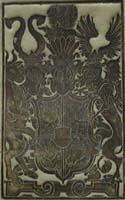 |
Coat of arms in black or gold with the crowned bull’s head of Mecklenburg, the griffin of Rostock, the arm of Stargard, and the bull’s head of Wenden. On the inescutcheon the arms of Schwerin. The three crests are the two bullhorns of Schwerin, a plume behind a crowned bull’s head, and a pair of wings. Supported by a bull and a griffin. Placed on the front or back cover. |
The Duchy of Mecklenburg (16th-17th centuries). Quite a few books with a Mecklenburg ownership mark came to the Royal Library via Sophie (1557-1631), Frederik II’s queen, who was the daughter of Duke Ulrik (d. 1603) and Duchess Elisabeth (d. 1586) of Mecklenburg. Sophie inherited part of her father’s library, but she also purchased books of her own. Duke Ulrik’s books often bear his initials on the front cover: V H Z M (Ulrik Herzog Zu Mecklenburg). Stamm-Buch, darinnen Christlicher Tugenden Beyspiel, Einhundert ausserlesener Emblemata (1619). |
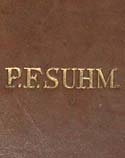 |
Ownership mark in gold: P.F. SUHM. Placed on the front cover. See another example here. |
Peter Frederik Suhm (1728-1798), collector of books, historian. He sold his entire library of c. 100,000 volumes to the Royal Library in 1796. See his signature inside a book here. Immanuel Kant: Critik der practischen Vernunft (1788). |
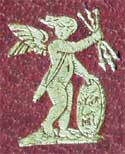 |
Super ex libris in gold: cupid holding three arrows and leaning against a shield with a face. Placed on the front cover. |
Frederik Walter (1649-1718), collector of books, Court official. His library which comprised c. 1,000 volumes, was sold at auction in 1719. Today the Royal Library owns about 50 books and 35 manuscripts from Walter’s library, and the manor Overgaard in Jutland owns about 30 volumes. Nouum Testamentum (Græcum), vol. I (1549). |